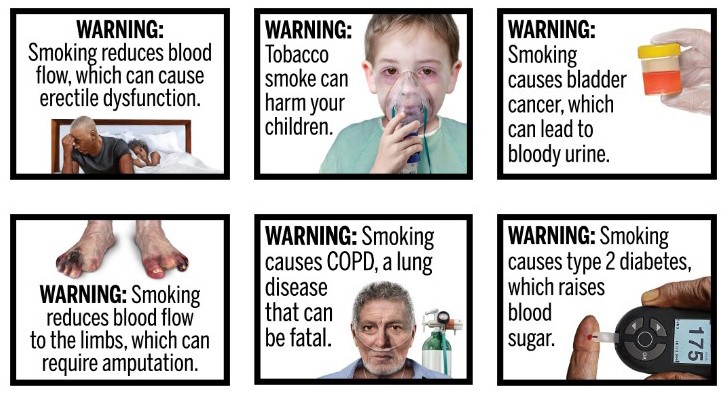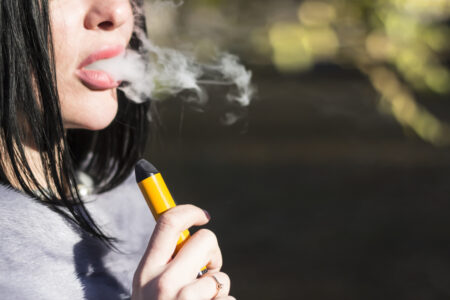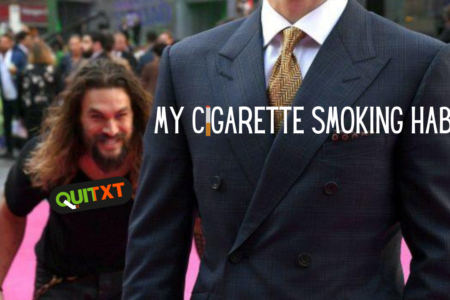
Share On Social!
The U.S. Court of Appeals for the Fifth Circuit recently unanimously upheld the U.S. Food & Drug Administration’s mandate for graphic health warning labels on cigarette packs and advertising.
The graphic health warning labels show written statements with photo-realistic color images depicting some serious health risks of cigarette smoking. Risks include impact to fetal growth, cardiac disease, diabetes, and more.
In recent years, Salud America! members sent emails to FDA in favor of the labels.
Now, the appeals court upheld the FDA requirement for the labels and rejected “arguments from R.J. Reynolds that the labels violate the First Amendment or take up too much space on packages,” according to the Public Health Law Center (PHLC).
“In upholding the graphic warning labels, the Fifth Circuit determined that the warnings are ‘factual and uncontroversial’ and promote a legitimate government interest,” said the PHLC.
Let’s explore what this ruling means and how it will impact smoking rates.
How Did We Arrive at Graphic Health Warning Labels on Cigarette Packs?
In 2009, Congress mandated graphic health warnings on cigarettes.
The issue lingered in legal battles for years as graphics were developed and revised.
In 2020, the FDA, fueled by public input, approved 11 graphic health warning labels and aimed to require tobacco companies to add to cigarette packs starting June 18, 2021.
However, the tobacco industry pushed back against the ruling in the case R.J. Reynolds v. FDA.
In the case, the tobacco industry argued that the FDA’s graphic health warnings requirement for cigarette packages and advertising violated the industry’s First Amendment rights.
The timeline of the case consists of:
- December 7, 2022: The district court granted the industry partial summary judgment, finding that the FDA’s graphic health warnings requirement for cigarette packages and advertising violated the industry’s First Amendment right.
- February 1, 2023: The FDA appealed this decision to the Fifth Circuit.
- March 21, 2024: The Fifth Circuit reversed and remanded, finding that the FDA’s graphic warning rule did not violate the First Amendment.
As for what’s next, the appeals court sent the issue back to a lower court.
The tobacco industry could eventually appeal to the Supreme Court, according to Slate.
Why Are Warning Labels Needed on Cigarette Packs?
Smoking remains the single largest preventable cause of death and illness in the world, causing an estimated U.S. 480,000 deaths every year, or about 1 in 5 deaths.

Cigarette smoke contains 7,000 chemicals. It has been linked to cancer and threatens the health of non-smokers through exposure to secondhand and thirdhand smoke.
While rates have gone down, over 32.4 million American adults still smoke cigarettes, according to the American Cancer Society. In South Texas, cigarette smoking rates are high among Mexican Americans, ranging up to 25.7%.
Certain groups suffer disproportionately from smoking-related diseases.
“These populations tend to be those who experience inequities in multiple areas of their lives, including those at lower socioeconomic levels, those without college degrees, American Indians/Alaska natives, African American/Black communities [and Latinos] … and others,” the American Cancer Society reports.
How Can the Warning Labels Impact Cigarette Smoking and Health?
The appeals court decision for warning labels is important, according to the PHLC.
“It reinforces the government’s power to implement public health advisories, which will likely result in reductions in smoking rates and associated illnesses,” according to the PHLC.
This ruling is a step forward, with graphic warnings being more noticeable than previous text-only warning labels. Graphics must occupy at least 50% of the front and back of cigarette packs and 20% of space on each cigarette advertisement, according to Slate.
“[Graphic warnings] are supported by extensive scientific evidence showing that graphic warnings are most effective at increasing public understanding of the dire health consequences of smoking,” according to the American Lung Association.
What Else Can We Do to Address Smoking and Health?
Secondhand smoke exposure is linked to several types of cancers, heart disease, stroke, lung cancer, and more frequent and severe asthma attacks, respiratory infections, and more.
The CDC indicates there is “no risk-free level of exposure to secondhand smoke.”
That is why Salud America! at UT Health San Antonio created the “Help Your City Adopt Smoke-Free Multifamily Housing” action pack.
The action pack, part of the Mil Gracias campaign, will help you engage local leaders in exploring a smoke-free multifamily housing policy for common areas and individual units.
“Experts say a smoke-free multifamily housing policy can protect the health of tenants and staff of apartments from secondhand smoke, as well as save property owners money in unit maintenance, fire prevention, insurance, and reduced legal liability,” Ramirez of Salud America! said.
Are You Ready to Quit Smoking?
Are you or someone you know looking to quit smoking?
It can be as easy as swiping through your smartphone.
Get help from Quitxt, a bilingual messaging service led by Dr. Amelie Ramirez, head of Salud America! at UT Health San Antonio.
To join Quitxt, text “iquit” (for English) or “lodejo” (for Spanish) to 844-332-2058.
More than 1 in 5 Quitxt users fully quit smoking after completing the English version, according to 2017 data in the journal Health Promotion Practice.
“There’s no better time than now to stop smoking with help from Quitxt,” said Dr. Amelie Ramirez, director of Salud America! at UT Health San Antonio. “Quitting smoking is proven to improve your health, increase your life span, and save money.”
Visit the Quitxt website for more information and tools in both English and Spanish that can help you or someone you know quit smoking today!
Explore More:
Quit SmokingBy The Numbers
24
percent
of Mexican American-nonsmokers are exposed to secondhand smoke



